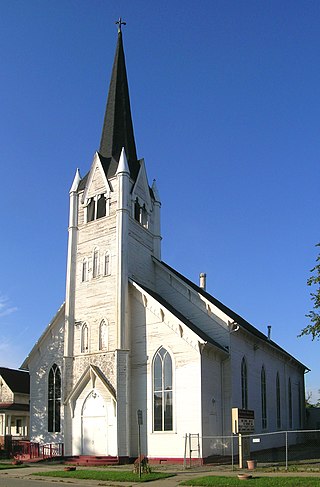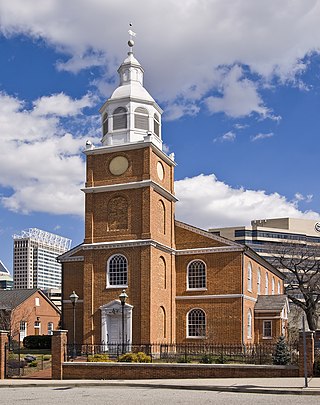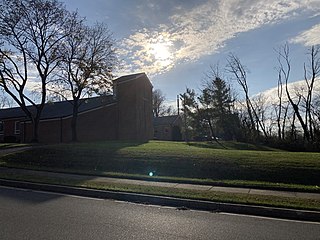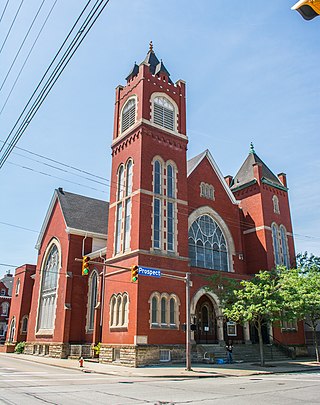
Christ Church refers to both an Episcopal parish currently located in Matapeake, Maryland and the historic church building located in the Stevensville Historic District in Stevensville, Maryland, which the parish occupied from 1880 to 1995, and that is now a Lutheran church. Christ Church Parish was one of the original 30 Anglican parishes in the Province of Maryland.

B'nai Israel Synagogue is a Modern Orthodox synagogue located in the historic Jonestown neighborhood, near downtown and the Inner Harbor of Baltimore, Maryland, in the United States. The synagogue is one of the oldest synagogue buildings in the United States.

The First Unitarian Church is a historic church and congregation at 12 West Franklin Street in Mount Vernon, Baltimore, Maryland. Dedicated in 1818, it was the first building erected for Unitarians in the United States. The church is a domed cube with a stucco exterior. The church, originally called the "First Independent Church of Baltimore", is the oldest building continuously used by a Unitarian congregation. The name was changed in 1935 to "The First Unitarian Church of Baltimore " following the merger with the former Second Universalist Church at East Lanvale Street and Guilford Avenue in midtown Baltimore. The American Unitarian Association and the Universalist Church of America (established 1866) representing the two strains of Unitarian Universalism beliefs and philosophies merged as a national denomination named the Unitarian Universalist Association in May 1961.

The Lloyd Street Synagogue is a Reform and Orthodox Jewish former synagogue located on Lloyd Street, Baltimore, Maryland, in the United States. The Greek Revival-style building is the third oldest synagogue building in the United States and was the first synagogue building erected in Maryland. The building was listed on the National Register of Historic Places in 1978 and designated as a Baltimore City Landmark in 1971.

The Gethsemane Evangelical Lutheran Church is a church located at 4461 Twenty-Eighth Street in Detroit, Michigan. It was designated a Michigan State Historic Site in 1980 and listed on the National Register of Historic Places in 1982. The building now houses the Motor City Missionary Baptist Church.

B'er Chayim Temple is a Reform Jewish congregation and synagogue, located in Cumberland, Maryland, in the United States. As of 2008, B'er Chayim counted approximately 50 families as members.

Knoxville is an unincorporated community in Frederick and Washington counties, Maryland, United States. The Robert Clagett Farm and Magnolia Plantation are listed on the National Register of Historic Places.

First Presbyterian Church and Manse is a historic Presbyterian church located at West Madison Street and Park Avenue in the Mount Vernon-Belvedere neighborhood of Baltimore, Maryland, United States. The church is a rectangular brick building with a central tower flanked by protruding octagonal turrets at each corner. At the north end of the church is a two-story building appearing to be a transept and sharing a common roof with the church, but is separated from the auditorium by a bearing wall. The manse is a three-story stone-faced building. The church was begun about 1854 by Norris G. Starkweather and finished by his assistant Edmund G. Lind around 1873. It is a notable example of Gothic Revival architecture and a landmark in the City of Baltimore.

Baltimore Hebrew Congregation Synagogue is an historic former Reform Jewish synagogue building located in the Madison Park neighborhood of Baltimore, Maryland, in the United States.

Otterbein Church, now known as Old Otterbein United Methodist Church, is a historic United Brethren church located in Baltimore, Maryland, United States. The first "German Reformed" church was built to serve the German Reformed and some Evangelical Lutheran immigrants, and later entered the Brethren strain of German Reformed Protestantism in the later Church of the United Brethren in Christ.

Sharp Street Memorial United Methodist Church and Community House is a historic United Methodist church located at Baltimore, Maryland, United States. It is an 1898 Gothic Revival stone structure of massive proportions. It features sharply pitched gables, a square parapeted 85-foot-high bell tower, lancet windows, and Gothic influenced interior decorative detailing. The Community House is a Georgian Revival influenced brick structure, four stories high and built in 1921. The congregation was organized in 1787 and was highly influential in the antebellum freedom movement, the establishment of the first black school in Baltimore after the abolition of slavery, and the movement to foster the institution of the African American Methodist church. It is known as the "Mother Church" of Black Methodism in Maryland. The National Association for the Advancement of Colored People, during their formative years, held their meetings at this historic church.

Lovely Lane United Methodist Church is a historic United Methodist church at 2200 St. Paul Street in the Charles Village neighborhood of Baltimore, Maryland, United States.

Bishop Cummins Reformed Episcopal Church is a Reformed Episcopal Church congregation in Catonsville, Maryland. Founded in 1874, the building it occupied in Baltimore from 1879 to 1961 is listed on the National Register of Historic Places under the name Cummins Memorial Church.

Zion Evangelical Lutheran Church is a Neogothic Revival-styled church built in 1910 in Hartland, Wisconsin to serve its German-speaking Lutheran congregation. It was listed on the National Register of Historic Places in 1986.

The German Evangelical Lutheran Church of St. Mark is an historic former church and current synagogue building located at 323 East 6th Street between First and Second Avenues in the East Village neighborhood of Manhattan, in New York City, New York, United States.

Zion-St. Mark's Evangelical Lutheran Church, formerly known as Deutsche Evangelische Kirche von Yorkville and Zion Lutheran Church, is a historic Lutheran church at 339-341 East 84th Street in Yorkville, Manhattan, New York City. The congregation is a member of the Evangelical Lutheran Church in America.

Zion Lutheran Church is a historic Lutheran church located along Prospect Avenue near downtown Cleveland, Ohio, United States. Formed in the 1840s, the congregation built the present building shortly after 1900, along with an adjacent church school. Both buildings have been named historic sites. The school is no longer open.

St. Paul Lutheran Church is located in central, Davenport, Iowa, United States. It is affiliated with the Evangelical Lutheran Church in America (ELCA). The church's original property, which subsequently housed other Protestant congregations, was listed on the National Register of Historic Places in 1983, but has since been torn down. The present complex was built in 1952 and contains two buildings that are contributing properties in the Vander Veer Park Historic District. The present church building was completed in 2007.
The history of the Germans in Baltimore began in the 17th century. During the 19th century, the Port of Baltimore was the second-leading port of entry for immigrants, after Ellis Island in New York City. Many Germans immigrated to Baltimore during this time.






















